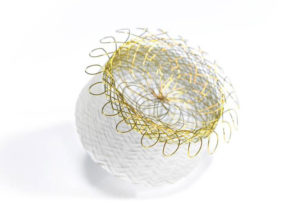
The first-in-man study exploring the safety, feasibility and neurological outcome with the Occlutech left atrial appendage (LAA) occluder (Occlutech) has shown a 93% procedural success rate and acceptable efficacy at three months for stroke prevention in patients with atrial fibrillation (AF) and a HAS-BLED score ≥3.
The study, published by Barbara Bellmann (Charité – Universtätsmedizin Berlin, Berlin, Germany) and others in the Journal of Cardiovascular Electrophysiology also demonstrated no significant neurological deficits.
Currently, there are two LAA closure systems available in Europe: the Watchman LAA closure device (Boston Scientific) and the Amplatzer Amulet LAA occluder (Abbott). Watchman is the only device commercially available in the USA. The Occlutech device is undergoing preliminary in-human investigation.
The Occlutech device “adapts itself through its softness to the anatomy of the LAA,” write Bellmann et al. Therefore, “it may be an option for patients with absolute contraindications for oral anticoagulation”. Additionally, the authors comment, the Occlutech Steereable Sheath has the flexibility to rotate 180° to reach LAAs facilitating device implantation. The sheath is used for transseptal puncture and a change to a delivery sheath is not necessary, which “could lead to a reduction of the procedure time and the prevention of complications,” they note.

In this prospective study, 30 patients (mean age 74±8 years, 19 male) were treated with the Occlutech device, between 2012 and 2016, at the Klinikum Coburg in Coburg, Germany. All patients had an indication for oral anticoagulation and were either at a high risk of bleeding or suffered from previous bleeding events—including cerebral and gastrointestinal bleeding. The mean CHA2DS2-VASC and HAS-BLED scores were 4±1.
The authors comment that the Occlutech device was successfully implanted in 28 of the 30 patients enrolled (93%). Two patients had to receive another device (Amplatzer Amulet) due to their “shallow LAA anatomy”, Bellmann et al note. After device implantation, 86% of the patients had sufficient LAA closure without leakage confirmed by transesophageal echocardiography. A leak less than 3mm was reported after implantation in four patients.
After three-month follow-up, 27 patients showed a correct placement of the device. The researchers found that one device was twisted but still stable with a complete occlusion of the LAA. Two patients had a persistent leak of less than 3mm. At one month, two patients showed a thrombus formation at the device and were treated with warfarin. At three months, only one patient of the two patients reported presented a persistent thrombus; however, the size of the thrombus became smaller. Both patients continued oral anticoagulation treatment without signs of bleeding.
Twelve patients completed follow-up at 12 months. All of them showed a correct placement of the device and none of the patients presented with a persistent leak of <3mm or >3mm. The investigation of the thrombus formation in the two patients reported earlier was still outstanding at 12 months.
Bellmann et al also reported that no patients developed a clinically apparent stroke or died during three- and 12-month follow-up.
Neurological examinations were performed by neurological specialists in all patients within 24 hours prior to and following LAA closure as well as one and three months after the procedure. The researchers reported no significant neurological changes at any of these time frames. The authors point out that silent cerebral lesions are often identified following interventional cardiology procedures. “This is the first-in-men study and we presented the first experience with the new Occlutech device, so it is a very pleasing result that no significant neurological abnormalities occurred after the procedure,” they note.
Although three-month follow-up success of LAA with the Occlutech device was high in this study and comparable to initial experiences with Watchman and Amplatzer, Bellmann et al suggest the confirmation of these results in a larger randomised trial.
The Occlutech LAA occluder received the CE mark approval in June 2016.








